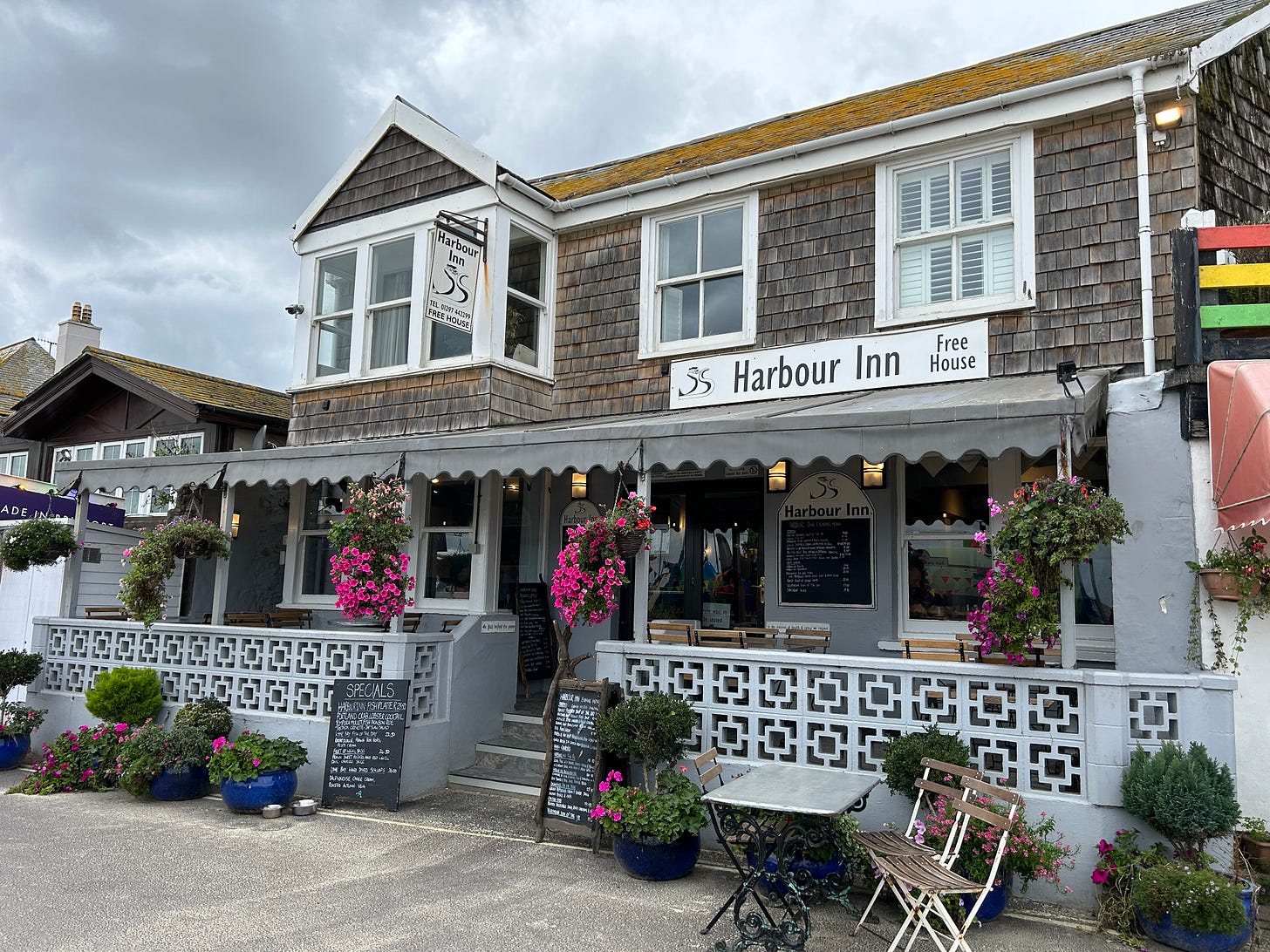Lyme Regis - the birthplace of Mary Anning
An October exploration Part 1
Lyme Regis on the Jurassic Coast
One of my favourite places on the south coast of England is Lyme Regis. Situated on the Jurassic Coast, Lyme Regis rises upwards from the sea and walking uphill is compulsory! I like to visit this quaint town whenever I need some sea air.
The town has a long history and many interesting, beautiful buildings and features. This area is known for its fossils; in Lyme Regis, several shops sell them. If you want to try fossil hunting, you can find them in the rocks along the shoreline. If you don’t mind risking spraining an ankle by walking over the rocks at Monmouth Beach, you will surely see some. If your legs can withstand it, you will reach the Ammonite Pavement at low tide, the only type of its kind. This is a flatter area where ammonites are clearly visible.
More about fossils and ammonites later. Monmouth Beach will be in a follow-up article.
Back to the history of Lyme Regis. The town can trace its roots back to Saxon times. It is recorded in the Domesday Book 1086. The town takes its name from the River Lym, or Lim, flowing through it. The Regis part was added in 1284 when a Royal Charter was granted by King Edward l. In 1591, the charter was confirmed by Queen Elizabeth l. The town is not large and has a population of around 4000, which swells considerably in the tourist season.
I will split this article into several parts, as the extra words will be worth it. For this part of the account of my visit in mid-October, let’s start at the eastern tip on the seafront. A lot of work has been done here to prevent erosion. The cliffs on this part of England’s coast are very soft and are subject to collapse. Please don’t get too close to the bottom of them or stand on the edge at the top. My first stop is to take a look and photograph the statue of Mary Anning.
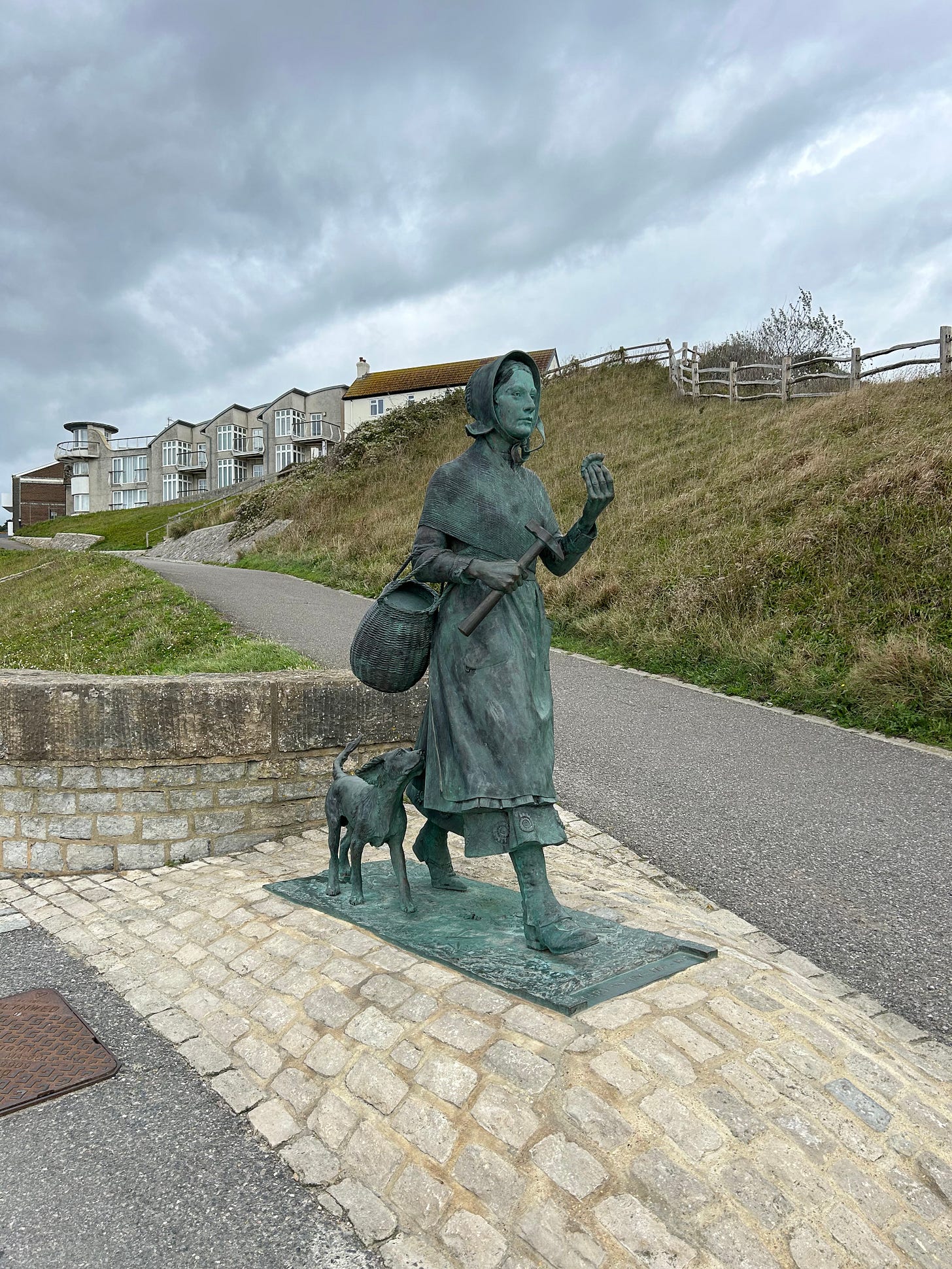
Who was Mary Anning?
Mary Anning was born in Lyme Regis in 1799 in a house on the site of what is now the Lyme Regis Museum. Her family were religious dissenters, Protestants and poor. The record is unclear, but there were nine or ten children, and only Mary and her brother Joseph reached adulthood.
Her father, Richard, was a cabinet maker and an amateur fossil collector. Mary loved to help him collect the fossils. As a little girl, I can imagine the fun Mary would have had with her dad on the beach, spending her time examining and breaking rocks for those intriguing fossils. Although poor, Mary had been taught to read and write with the help of her Sunday school.
This is a paywalled post. You'll be able to read the first several paragraphs. After that, you'll have to become a paying subscriber to continue reading. I hope you'll consider converting so you can read all of my posts in their entirety. This newsletter is 100% supported by readers like you. In any case, many thanks for being here.
Richard died in 1810 from Tuberculosis and previous injuries, leaving the family in a precarious situation, especially in those days. Joseph became an apprentice upholsterer, and Mary sold her fossil finds to pay off family debts.
Mary Anning’s biographer, George Roberts wrote: “Mary Anning was born a dull child but after the accident grew up lively and intelligent.”
He was referring to an incident when at only 15 months of age she was taken to an outdoor eqestrian event by a family friend, Elizabeth Haskings along with two other women. A storm erupted and sheltering under a tree the trio were struck by lightening and killed. Mary appeared dead, was rushed home and given a warm bath. Thankfully, she revived. George credited the lightening strike to making her more intelligent.
Around 1811, when Mary was twelve, Joseph found a fossilised skull. Mary spent time on this and dug out the outline of its 5.2m long skeleton. Imagine the excitement! Locals thought she had found the remains of a monster, and this would have been the talk of the town for quite some while. The specimen caused consternation and was eventually named Ichthyosaurus, a fish lizard. Of course, it was neither a fish nor a lizard.
The years went by, and in 1823, Mary Anning was the first to discover a complete skeleton of a Plesiosaurus. People initially couldn’t believe it and thought it to be fake. It wasn’t long, though, before the discovery was accepted. Mary gained a reputation for finding and identifying fossils. Today, we call her a palaeontologist and a real fossil expert for her time. Mary faced a problem with male scientists. Typical of the time, and in some ways today, women could not possibly be as clever as men. Happy to buy fossils from Mary, many male scientists would not credit her for her work. This attitude continued for many decades, and it wasn’t until 1904 that The Geological Society of London admitted women.
In 1828, Mary also discovered the first Pterosaur outside of Germany. She certainly was good at discovering, recovering and identifying fossils. Had she not lived in Lyme Regis and enjoyed finding fossils with her dad, she would have had a very different life, as did many girls in the nineteenth century. Sadly, Mary died in 1847 at age 47 from breast cancer. Some of Mary’s finds can be found in London at the Natural History Museum.
Moving on!


The Town Mill - Lyme Regis
Returning to my walk and passing The Marine Theatre, I head down to the lowest level of the town and arrive at the Town Mill, just off Coombe Street. This mill has been milling for over 500 years; it dates from 1340. The Domesday Book (1086) records a mill in Lyme, and it could well have been this one! The timing is perfect as they are about to start milling, and a group of us is given a demonstration on starting the waterwheel and milling some wheat. Take a look at the video below. The mill is in complete working order, with many moving parts being extremely old.
Along with some other visitors, we go to the first floor and see the top of the overshot waterwheel, the only type that would work on such a shallow river as the Lym. This is a process that goes back to Roman times. The wheel is started, and we are told that the shaft turning the machinery was purchased back in 1799, and the mill still has the receipt! Mills were dangerous places as the dust in the air, if ignited, is two and a half times more explosive than dynamite. The dust, too, will cause the lifespan of millers to be significantly reduced, causing lung disease. The Victorians thought using wooded parts in flour mills was outdated and switched to metal. It wasn’t long before mills started catching fire as the metal parts created sparks igniting the flour in the air!
Click any image to see the full size.


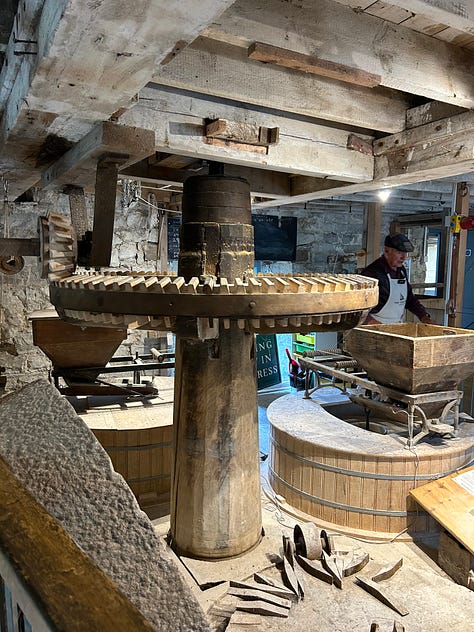
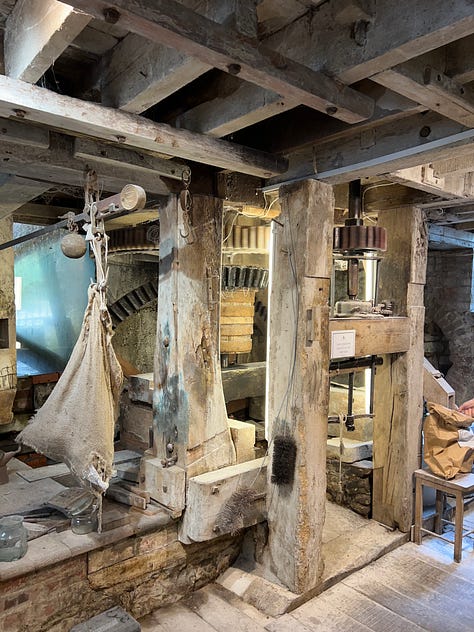
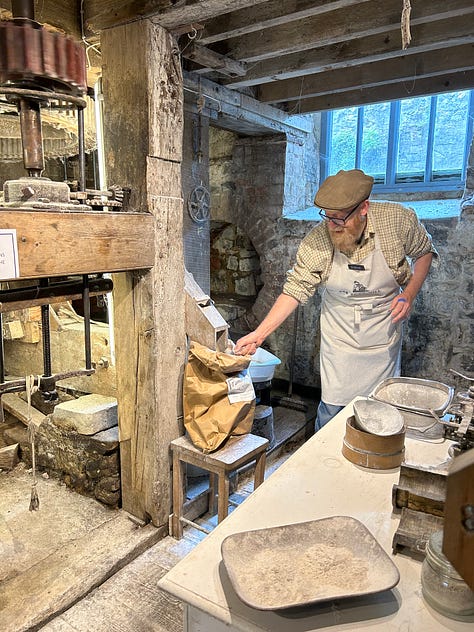

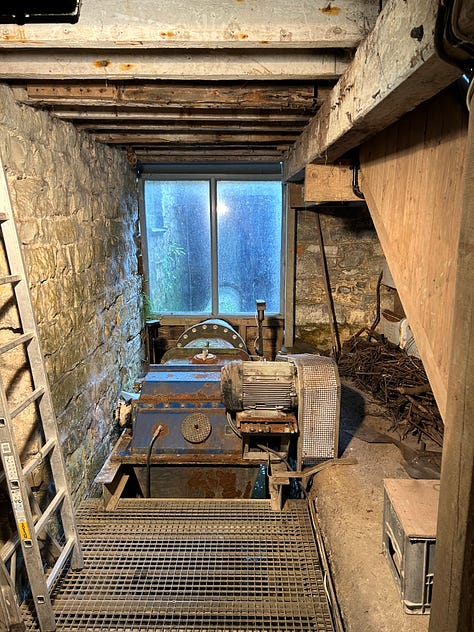


Climbing the stairs back down to ground level, we now see the miller and the results of the grain being ground between the Derbyshire Grit Stone wheels. The miller has to adjust the gap between the stones to get the correct consistency of the flour. The stones must not be allowed to touch. If they do, it’s game over, and a new set would be required.
Interestingly, the gentleman doing the milling explained that he was a biochemist and that many have gluten allergies due to modern wheat. He was in the process of milling wheat for an organic farm. They grow an ancient type of wheat that grows less tall and produces less grain than new varieties. His opinion is that we have less tolerance due to the new varieties. A search on the Internet found this, “Ancient grains still have gluten, but the makeup of the gluten is more easily processed and digested.”
Should you wish to buy flour ground at the mill, a good selection of types is on sale.
The area around the working part of the mill is still called Town Mill and includes a micro-brewery, The Lyme Regis Brewery, a couple of restaurants, several shops and a gallery. If you visit Lyme Regis, make sure you pay a visit. You can also walk alongside the River Lym on a paved footpath behind the mill.
Lyme Regis, thankfully, is still thriving, with few empty shops. On the seafront on Marine Parade, which we will get to soon, there is only one amusement arcade. The town has plenty of independent shops and good places to eat. The number of words in this article is steadily rising; therefore, I will show you the Harbour Inn, where Mrs M and I took a break for lunch, and then tell you more about this quaint seaside town and interesting stories next time.
The Harbour Inn, Lyme Regis
We have eaten at The Harbour Inn several times, and it was good to do so again. There were some lovely seafood dishes on the “Specials” board, but I have not had decent fish and chips for a while, so I opted for the British classic with mushy peas. Mrs M went with Lasagne. I don’t usually take photos of food, but as I intended to include this visit in this article, I did - just for you.
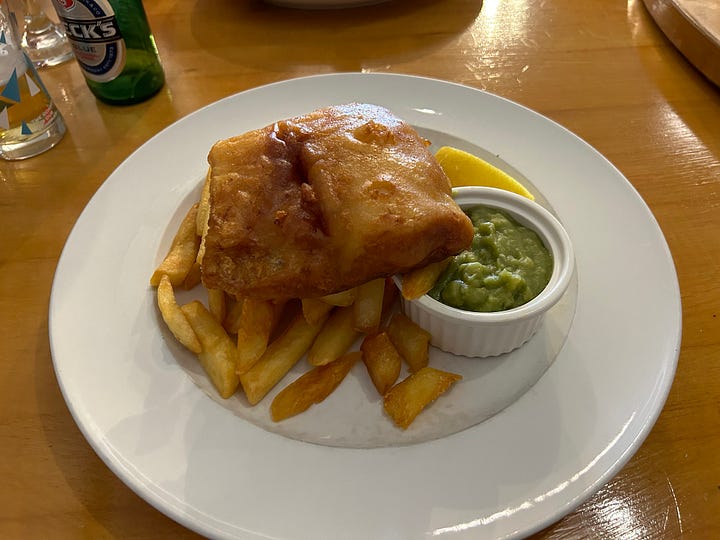

The food was good. The two meals, a glass of wine for the sophisticated Mrs M, a non-alcoholic lager for me, finished with a pot of tea for two, cost a few pennies over £45, quite fair in today’s market.
In the following article, I will tell you about The Cobb and a search for fossils.
If you are enjoying my travels, please refer a friend. You could gain some free months for a paid subscription. Your friend needs only to become a free subscriber. Gift subscriptions are also available.





